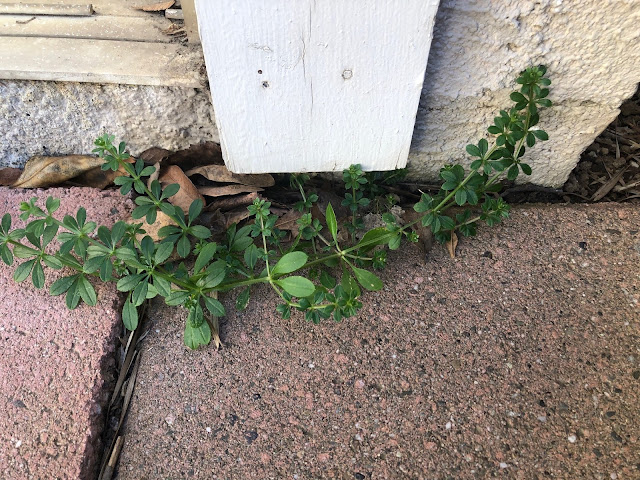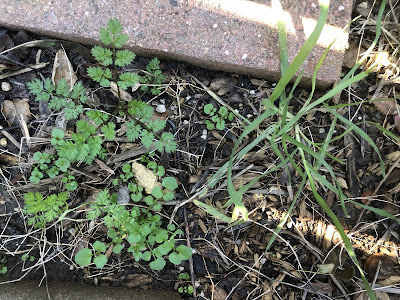
Get them out now for an easier spring

|
|
Bedstraw, a prickly weed hated by pet owners, already has grown quite a bit against a west-facing wall. But not for long. (Photos: Kathy Morrison)
|
The popular comic Pearls Before Swine last May had a strip that still decorates my refrigerator. In the first panel, Rat (the snarky character) asks Goat (the sensible one) what he's doing. Here's how the rest of it plays out:
Goat: Pulling the weeds in my garden.
Rat: We haven't had to do that at all in our garden this year.
Goat: Oh, yeah? What are you growing?
Rat: Weeds.
The last panel shows Rat talking to another friend, Pig. "No one appreciates my gardening tips," he says.
So ... unless you're like Rat and plan to have a garden of weeds this year, here's my gardening tip: Get them out while they're small.
Our weather has been just nice enough that weed seeds, fed by December's rains, are now sprouting all over. It can be hard to identify weeds without their flowers, but now is when it's easiest to get rid of them.

|
|
A sampler of the types of weeds you may already see in the
garden, including little bittercress (lower left and a small one
top center) and grasses. The carrot-looking plant top left also is a weed. |
-- They hog water and nutrients that could be going to wanted plants.
-- They harbor pests (insects and rodents) and pathogens that can sneak up on seedlings and transplants.
-- The roots only grow stronger and tougher to eradicate.
-- Allowed to grow and flower, some weeds then spread by underground runners, tubers or rhizomes, or burrs that attach to pets' fur. Others produce allergens.
The UC Integrated Pest Management Program (UC IPM) filmed a great talk on weeds last year with John Roncoroni, a retired UCCE weed science farm adviser. He discusses ways to identify weeds, but also covers the why of controlling weeds, and priorities for tackling them. Here's the link to the YouTube video . (It's about 39 minutes.)
So whether you prefer using a sharp hoe, or a trowel or specialized weeding tool, tackle the weeds now -- before you need a shovel.
Or give up, like Rat, and just grow weeds.
----
Here are links to some of our previous posts on weeds:
Is this the worst weed in Sacramento? (nutsedge)
Eeek! It's weed season already (5 problem plants to get rid of now)
Comments
0 comments have been posted.Sacramento Digs Gardening to your inbox.
Sites We Like
Garden Checklist for week of May 12
Get your gardening chores and irrigation done early in the day before temperatures rise.
* Plant, plant, plant! It’s prime planting season in the Sacramento area. Time to set out those tomato transplants along with peppers and eggplants. Pinch off any flowers on new transplants to make them concentrate on establishing roots instead of setting premature fruit.
* Direct-seed melons, cucumbers, summer squash, corn, radishes, pumpkins and annual herbs such as basil.
* Harvest cabbage, lettuce, peas and green onions. This heat will cause leafy greens and onions to flower; pick them before they bolt.
* In the flower garden, direct-seed sunflowers, cosmos, salvia, zinnias, marigolds, celosia and asters.
* Plant dahlia tubers. Other perennials to set out include verbena, coreopsis, coneflower and astilbe.
* Transplant petunias, marigolds and perennial flowers such as astilbe, columbine, coneflowers, coreopsis, dahlias, rudbeckia and verbena.
* Keep an eye out for slugs, snails, earwigs and aphids that want to dine on tender new growth.
* Feed summer bloomers with a balanced fertilizer.
* For continued bloom, cut off spent flowers on roses as well as other flowering plants.
* Got fruit trees? If you haven't already done so, thin orchard fruit such as apples, peaches, pears, pluots and plums before they grow too heavy, breaking branches or even splitting the tree. Leave the largest fruit on the branch, culling the smaller ones, and allow for 5 to 6 inches (or a hand's worth) between each fruit.
* Thin grape bunches, again leaving about 6 inches between them. For the remaining bunches, prune off the "tail" end, about the bottom third of the bunch, so that the plant's energy is concentrated in the fruit closest to the branch.
* As spring-flowering shrubs finish blooming, give them a little pruning to shape them, removing old and dead wood. Lightly trim azaleas, fuchsias and marguerites for bushier plants.
* Add mulch to the garden to help keep that precious water from evaporating. Mulch also cuts down on weeds. But don’t let it mound around the stems or trunks of trees or shrubs. Leave about a 6-inch to 1-foot circle to avoid crown rot or other problems.